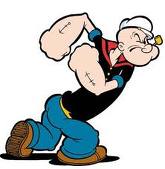 |
| Popeye |
Popeye the Sailor Man is a fictional hero notable for appearing in comic strips and animated films as well as numerous television shows. He was created by Elzie Crisler Segar, and first appeared in the daily King Features comic strip Thimble Theatre on January 17, 1929. Popeye has now become the strip's title as well.
Although Segar's Thimble Theatre strip, first published on December 19, 1919, was in its tenth year when Popeye made his debut, the sailor quickly became the main focus of the strip and Thimble Theatre became one of King Features' most popular properties during the 1930s.
Thimble Theatre was carried on after Segar's death in 1938 by several writers and artists, most notably Segar's assistant Bud Sagendorf. The strip, now titled Popeye, continues to appear in first-run installments in its Sunday edition, written and drawn by Hy Eisman. The daily strips are reprints of old Sagendorf stories.Although Segar's Thimble Theatre strip, first published on December 19, 1919, was in its tenth year when Popeye made his debut, the sailor quickly became the main focus of the strip and Thimble Theatre became one of King Features' most popular properties during the 1930s.
In 1933, Max and Dave Fleischer's Fleischer Studios adapted the Thimble Theatre characters into a series of Popeye the Sailor theatrical cartoon shorts for Paramount Pictures. These cartoons proved to be among the most popular of the 1930s, and the Fleischers—and later Paramount's own Famous Studios—continued production through 1957. The cartoons are now owned by Turner Entertainment, a subsidiary of Time Warner, and distributed by sister company Warner Bros. Entertainment.
Over the years, Popeye has also appeared in comic books, television cartoons, arcade and video games, hundreds of advertisements and peripheral products, and a 1980 live-action film directed by Robert Altman starring comedian Robin Williams as Popeye.
Theatrical Popeye cartoons on television
Famous/Paramount continued producing the Popeye series until 1957, with Spooky Swabs being the last of the 125 Famous shorts in the series. Paramount then sold the Popeye film catalog to Associated Artists Productions (a.a.p.), which was bought out by United Artists in 1958 and later merged with Metro-Goldwyn-Mayer, which was itself purchased by Turner Entertainment in 1986. Turner sold off the production end of MGM/UA shortly after, but retained the film catalog, giving it the rights to the theatrical Popeye library.
The black-and-white Popeye shorts were shipped to South Korea in 1985, where artists retraced them into color. The process was intended to make the shorts more marketable in the modern television era, but prevented the viewers from seeing the original Fleischer pen-and-ink work, as well as the three-dimensional backgrounds created by Fleischer's "Stereoptical" process. Every other frame was traced, changing the animation from being "on ones" (24 frame/s) to being "on twos" (12 frame/s), and softening the pace of the films. These colorized shorts began airing on Superstation WTBS in 1986 during their Tom & Jerry and Friends 90-minute weekday morning and hour-long weekday afternoon shows. The retraced shorts were syndicated in 1987 on a barter basis, and remained available until the early 1990s. Turner merged with Time Warner in 1996, and Warner Bros. (through its Turner subsidiary) therefore currently controls the rights to the Popeye shorts.
For many decades, viewers could only see a majority of the classic Popeye cartoons with altered opening and closing credits. a.a.p. had, for the most part, replaced the original Paramount logos with their own. In 2001, the Cartoon Network, under the supervision of animation historian Jerry Beck, created a new incarnation of The Popeye Show. The show aired the Fleischer and Famous Studios Popeye shorts in versions approximating their original theatrical releases by editing copies of the original opening and closing credits (taken or recreated from various sources) onto the beginnings and ends of each cartoon, or in some cases, in their complete, uncut original theatrical versions direct from such prints that originally contained the front-and-end Paramount credits.
The series, which aired 135 Popeye shorts over forty-five episodes, also featured segments offering trivia about the characters, voice actors, and animators. The program aired without interruption until March 2004. The Popeye Show continued to air on Cartoon Network's spin-off network Boomerang. The restored Popeye Show versions of the shorts are sometimes seen at revival film houses for occasional festival screenings. The Popeye Show is currently airing on Cartoon Network in Pakistan as well as in India. A daily half-hour block of Popeye is currently airing on the Boomerang network.
Post a Comment